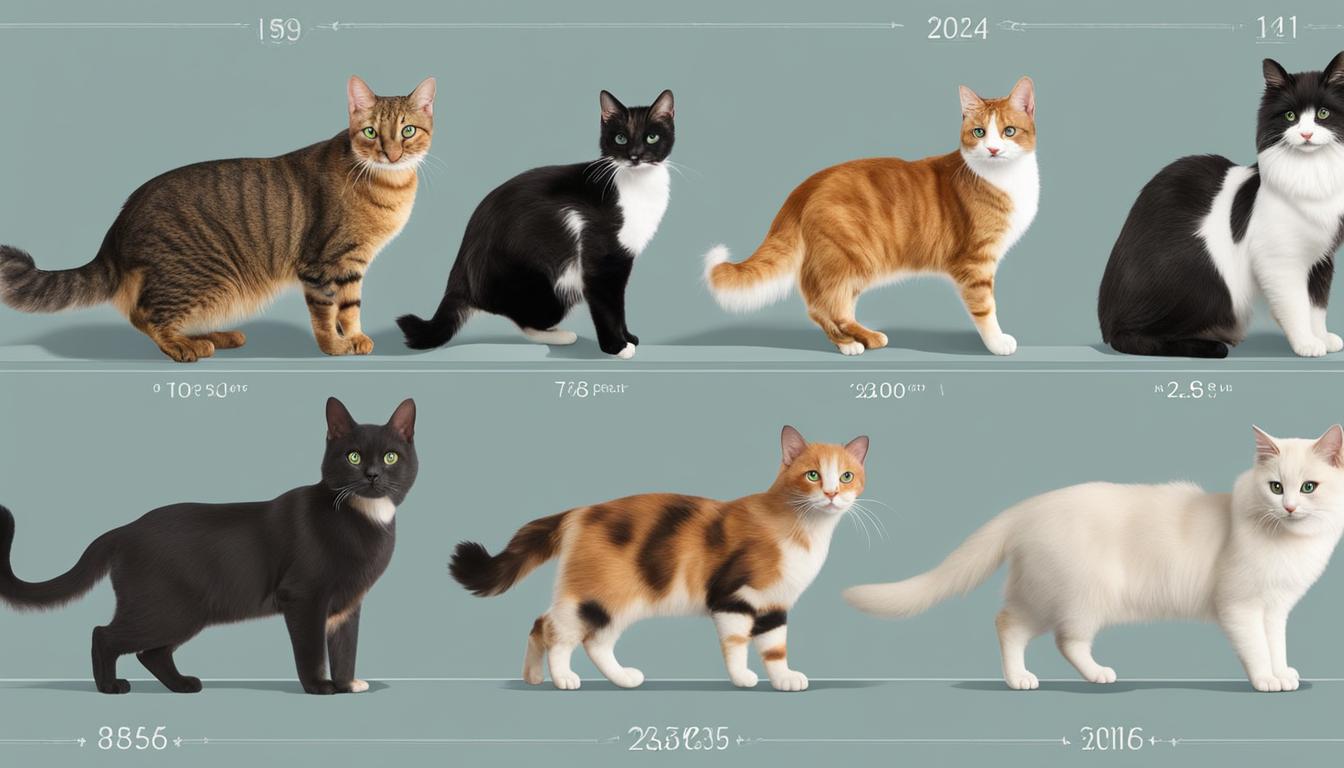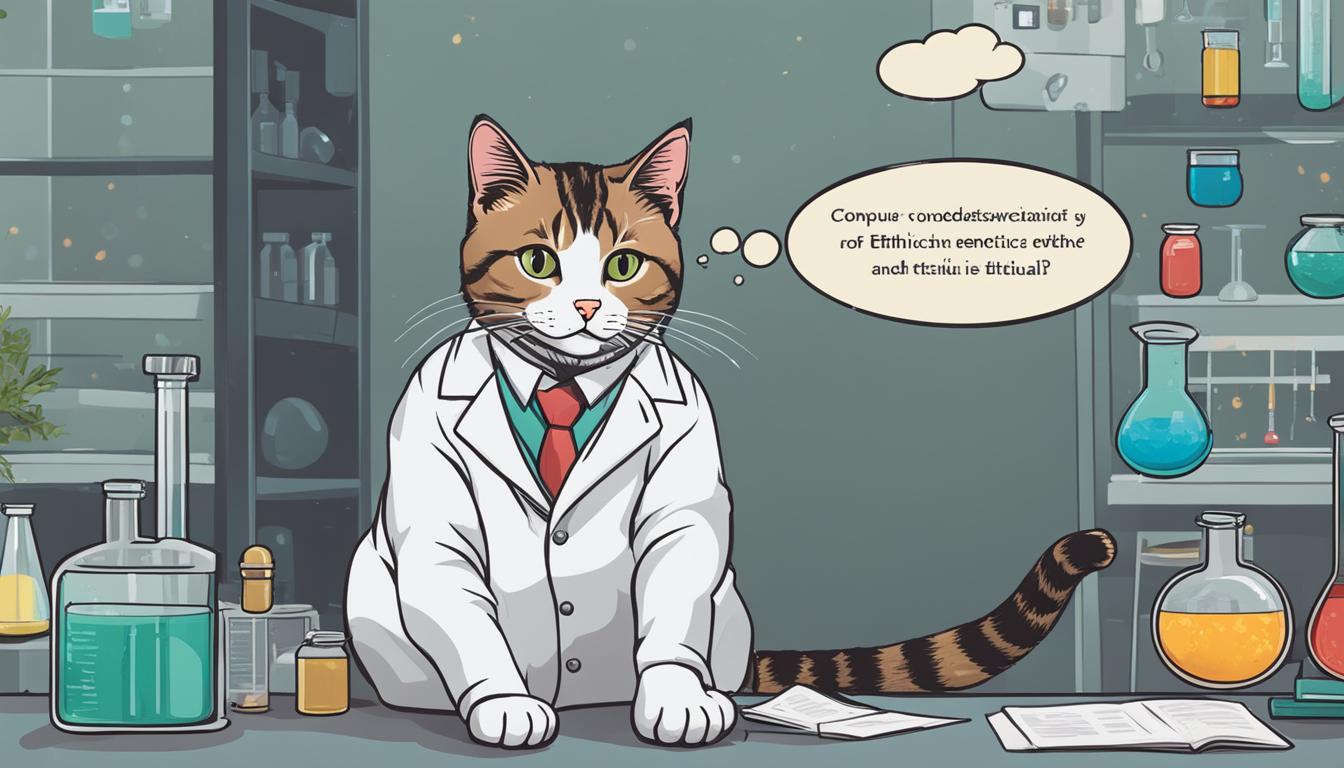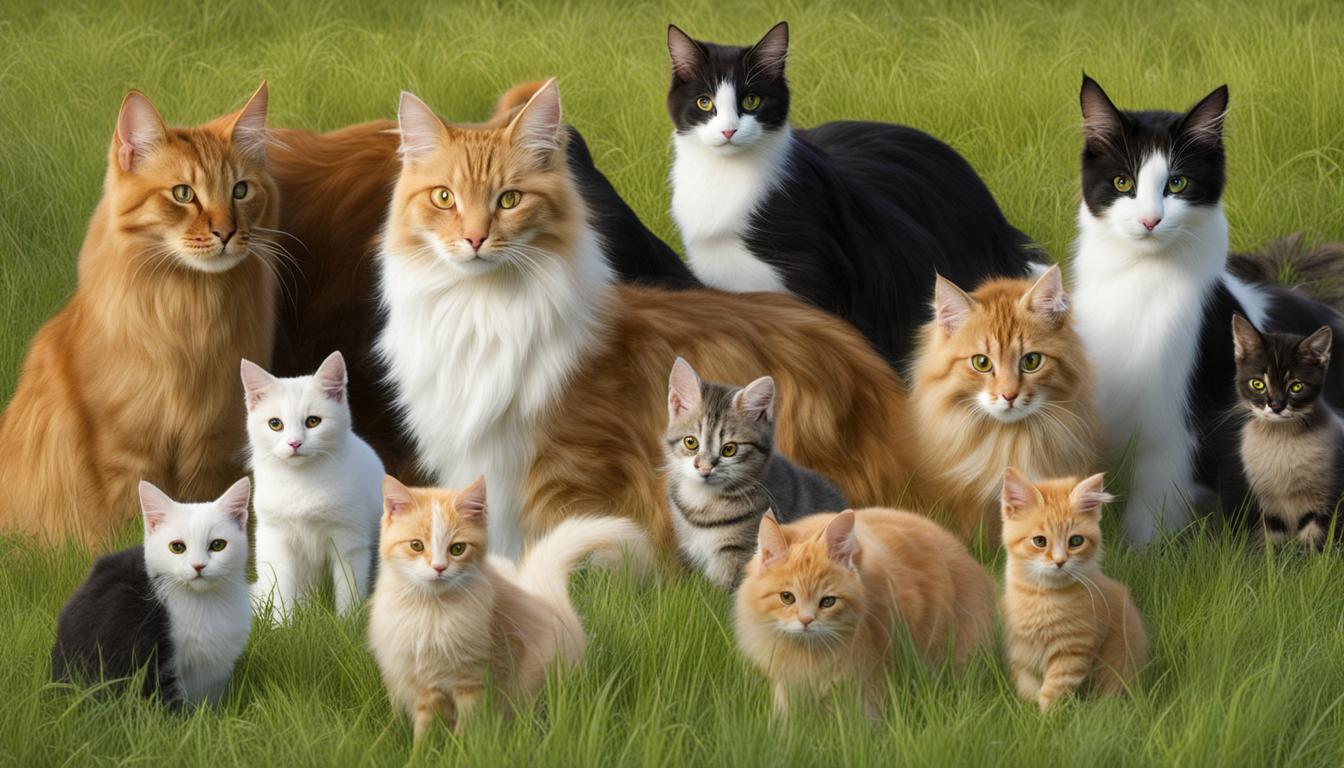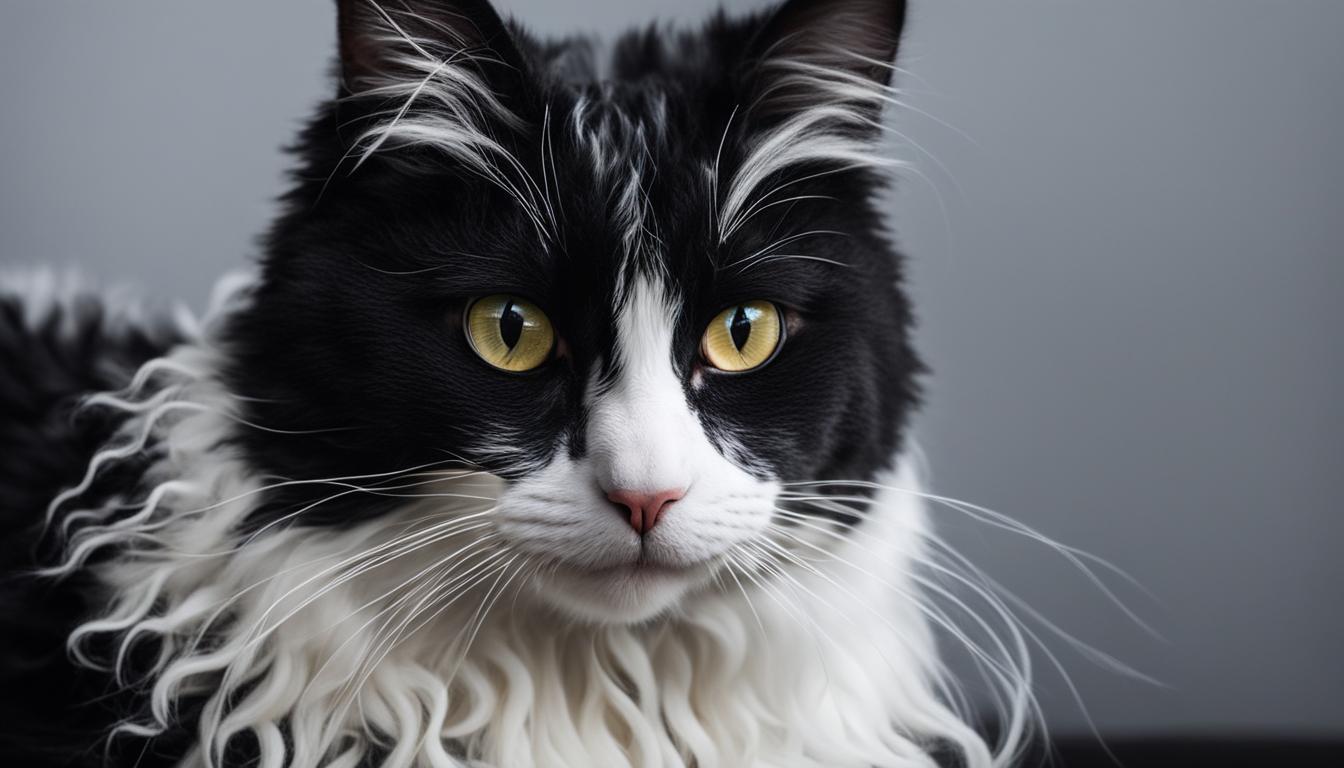As a self-proclaimed feline enthusiast, I am endlessly intrigued by the emergence of new cat breeds and the rich history behind their development. It’s remarkable to think that these furry companions we adore today have undergone a centuries-long journey of evolution and adaptation. From the ancient origins of domestication to the creation of modern breeds, the story of cat breed emergence is filled with curiosity and wonder.
Key Takeaways:
- The emergence of new cat breeds is a fascinating journey spanning centuries.
- Genetic analysis has provided insights into the origins and development of modern cat breeds.
- Cat breeds have evolved and adapted to different environments throughout history.
- Preserving genetic diversity is essential for the health and well-being of future cat generations.
- The ongoing recognition of new breeds contributes to the preservation and appreciation of feline diversity.
Tracing the Journey of the Maine Coon Cat
The Maine Coon cat, with its majestic stature and distinctive characteristics, has captivated cat lovers around the world. This breed has a fascinating history that is still the subject of speculation and curiosity. While the exact origins of the Maine Coon are unknown, several theories have emerged to shed light on its genetic makeup and development.
One theory suggests that the Maine Coon may have descended from the Norwegian Forest Cat, which is known for its similar physical attributes. Another theory proposes that the breed originated from cats brought to America by English seafarer Captain Charles Coon. Regardless of its exact origins, genetic research has shown that the Maine Coon has a high degree of genetic diversity, contributing to its overall good health. However, it is important to note that certain genetic disorders, such as Hypertrophic Cardiomyopathy (HCM), are more common in Maine Coons and require careful monitoring.
The exact origins of the Maine Coon cat may always remain a mystery, but its unique characteristics and genetic diversity continue to make it a beloved breed among cat enthusiasts.
Despite its mysterious beginnings, the Maine Coon has made a significant impact in popular culture and cat shows. Its large size, tufted ears, and striking appearance have made it a favorite subject in literature, movies, and advertising. The breed’s success in cat shows has also influenced breed standards and breeding practices, shaping the future of cat breeding. As a result, there has been a global demand for Maine Coon cats, thanks to their presence in popular media and their distinct charm.
| Distinctive Features | Maine Coon | Other Cat Breeds |
|---|---|---|
| Size | Larger than average | Varies |
| Coat | Long and shaggy | Varies |
| Ears | Tufted and lynx-like | Varies |
| Personality | Friendly, sociable, and intelligent | Varies |
The Maine Coon’s journey from its mysterious origins to its popularity in popular culture and cat shows is a testament to the breed’s unique qualities and enduring appeal. As we continue to unravel the mysteries of cat breeds, the Maine Coon stands as a testament to the rich genetic history and diversity within our feline companions.
The Maine Coon in Popular Culture and Show Business
The Maine Coon cat, with its striking appearance and charming personality, has not only captured the hearts of cat lovers but has also made a significant impact in popular culture and show business. From movies to literature and even advertising, the Maine Coon’s distinctive physical characteristics have brought it into the limelight.
One notable example of the Maine Coon’s presence in popular culture is its appearance in literature. The breed has been featured in various books, becoming an iconic representation of feline beauty and grace. Its large size, tufted ears, and luxurious coat make it a visually captivating subject for writers and readers alike.
The Maine Coon’s success extends beyond the pages of books. In movies and television, the breed often takes center stage, captivating audiences with its majestic presence. The breed’s unique combination of elegance and playfulness has made it a favorite choice for filmmakers and producers, further cementing its popularity in the entertainment industry.
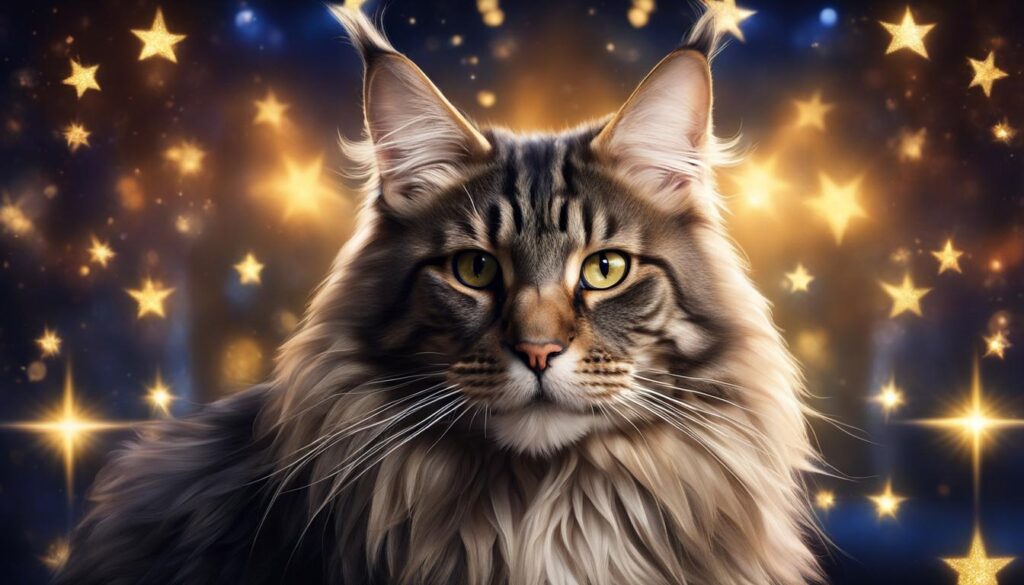
In addition to its role in popular culture, the Maine Coon has also made a mark in the world of cat shows. Its distinct characteristics and undeniable charm have earned it numerous accolades and titles. The breed’s success in cat shows has not only brought recognition to individual Maine Coon cats but has also influenced breed standards and breeding practices, shaping the future of cat breeding.
The Maine Coon’s influence on cat breeding goes beyond its show success. Its unique attributes have inspired cat enthusiasts and breeders to work towards creating new breeds that embody the Maine Coon’s desirable traits. This desire to capture the Maine Coon’s essence has led to the emergence of hybrid cat breeds, blending the Maine Coon’s distinct characteristics with other breeds to create even more captivating feline companions.
Table: Popular Representations of the Maine Coon in Media
| Medium | Description |
|---|---|
| Literature | The Maine Coon is often featured in books, symbolizing beauty and grace. |
| Movies and TV | The breed’s majestic presence and playful nature have made it a favorite choice in the entertainment industry. |
| Advertising | Maine Coons are often used in advertising campaigns to convey elegance and sophistication. |
| Cat Shows | The Maine Coon’s distinct characteristics have earned it recognition and awards in cat shows worldwide. |
The Diversity of Cat Breeds and Genetic Loss
When it comes to cat breeds, one cannot deny the incredible diversity that exists. From the hairless Sphynx to the majestic Maine Coon, each breed has its own distinct characteristics and traits. However, the development of these breeds has also led to a loss of genetic diversity within certain populations. Pure breeding, a practice used to maintain and alter aesthetic traits, has inadvertently resulted in reduced genetic variation.
Inbreeding, a common practice in cat breeding, can have detrimental effects on the overall health and well-being of the breed. Genetic disorders, such as Hypertrophic Cardiomyopathy (HCM), are more prevalent in certain breeds due to the limited genetic pool. This highlights the importance of responsible breeding practices and the need to prioritize genetic diversity to ensure the long-term health and vitality of our feline friends.
“The loss of genetic diversity in cat breeds is a double-edged sword. While breed standards and desired traits are maintained, the risk of inherited diseases and health issues also increases. It’s a delicate balancing act that breeders must navigate.”
Despite the potential drawbacks, it’s important to acknowledge that the diversity of cat breeds is a testament to the rich tapestry of feline genetic history. Each breed tells a unique story, shaped by the influence of indigenous cats and foreign long-haired varieties. This diversity not only adds to the beauty and charm of the feline world but also serves as a reminder of the importance of preserving and appreciating the genetic heritage of these remarkable creatures.
| Breed | Origin | Distinctive Traits |
|---|---|---|
| Maine Coon | United States | Large size, tufted ears |
| Bengal | United States | Leopard-like spots |
| Persian | Middle East | Long, luxurious coat |
| Siamese | Thailand | Distinctive blue eyes, color-point markings |
As we continue to explore the world of cat breeding and genetic diversity, it’s essential to strike a balance between preserving breed standards and maintaining the health and well-being of our feline companions. Responsible breeding practices, genetic testing, and a focus on genetic diversity are crucial in ensuring the longevity and vitality of cat breeds for generations to come.
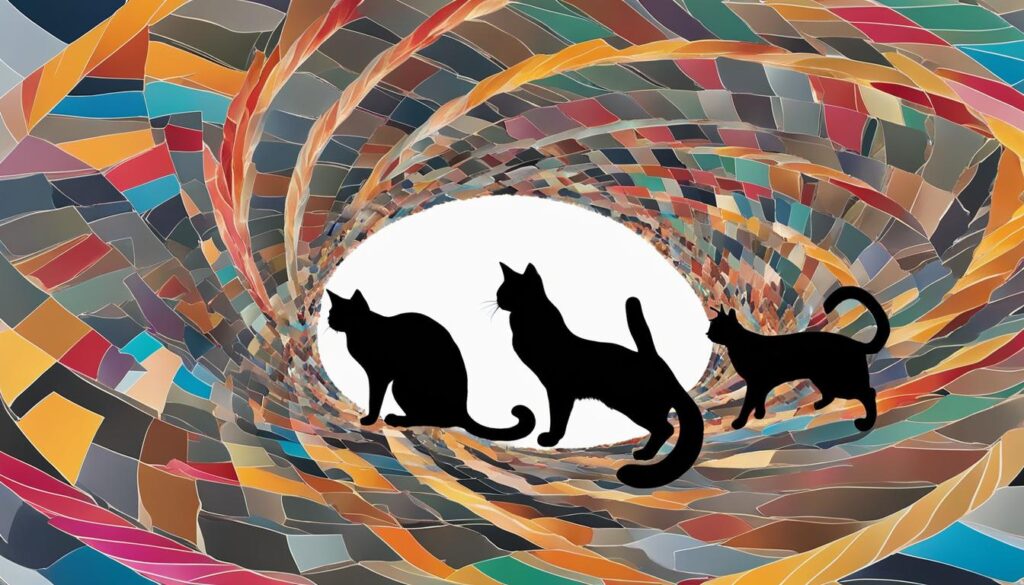
The Emergence of Hybrid Cat Breeds
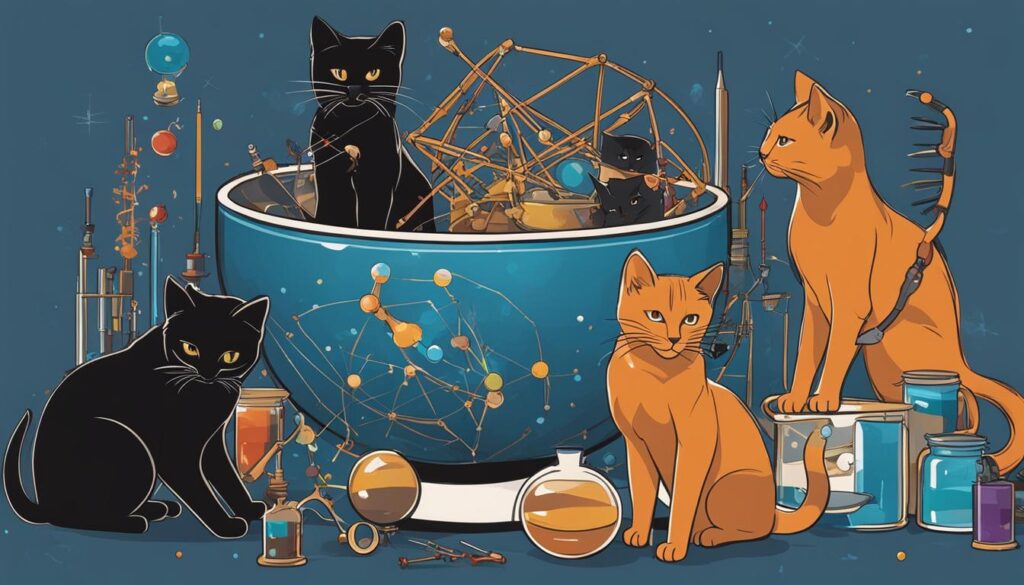
Hybrid cat breeds have become increasingly popular in recent years, captivating cat lovers with their unique characteristics and exotic appearances. These new breeds are the result of intentional breeding efforts aimed at combining the desirable traits of different cat breeds. The emergence of hybrid cat breeds has a rich historical background, showcasing the ongoing desire to create new and distinct feline companions.
One of the most well-known hybrid cat breeds is the Bengal cat, which resulted from crossing domestic cats with Asian leopard cats. This crossbreeding created a breed with stunning spots and a wild-looking coat. Another example is the Savannah cat, which originated from the crossbreeding of domestic cats with servals, a wild African cat species. Savannah cats are known for their tall stature and distinctive spotted coat patterns.
The rise of hybrid cat breeds has sparked both admiration and controversy within the cat breeding community. Proponents argue that hybrid breeding can lead to the development of healthier and more resilient breeds with a wide range of desirable traits. However, critics express concerns about potential health issues and the impact on the existing gene pool of purebred cats. Despite the ongoing debates, the popularity of hybrid cat breeds continues to grow, with new and exciting breeds emerging.
Recognition Process of Cat Breeds
When it comes to recognizing new cat breeds, the process is a meticulous one. Cat breed organizations and associations carefully evaluate each breed to establish breed standards and criteria before granting official recognition. This ensures that recognized cat breeds meet certain quality and consistency standards, upholding the integrity of each breed.
Over the years, numerous cat breeds have been newly recognized through intentional breeding efforts and the discovery of naturally occurring breeds. These newly recognized breeds bring a fresh perspective to the world of feline diversity, expanding our understanding and appreciation of different cat breeds.
Looking back into history, the classification of cat breeds has been an ongoing endeavor. Records indicate that cats have been recognized as distinct breeds for centuries, showcasing the long and storied history of cat breeding. The process of classifying cat breeds and formally recognizing them has played a crucial role in preserving and celebrating the diversity of feline species.
Historic Examples of Newly Recognized Cat Breeds
One such example is the Bengal cat, a breed recognized in the 1980s. The Bengal cat’s distinctive appearance, with its leopard-like spots and sleek body, caught the attention of cat enthusiasts around the world. Through selective breeding, breeders successfully combined the traits of Asian leopard cats and domestic cats, resulting in the creation of the Bengal breed.
Another notable example is the Scottish Fold cat, which gained recognition in the mid-20th century. Known for its unique folded ears, the Scottish Fold captivated cat lovers with its adorable appearance. The breed’s distinct genetic mutation, which causes the folding of the ears, was discovered in a farm cat in Scotland. Since then, the Scottish Fold has become a recognized breed worldwide.

| Newly Recognized Cat Breeds | Year of Recognition |
|---|---|
| Bengal | 1980s |
| Scottish Fold | Mid-20th century |
| New Breed 1 | Year of Recognition 1 |
| New Breed 2 | Year of Recognition 2 |
Table: Examples of Newly Recognized Cat Breeds and Their Year of Recognition
The recognition process of cat breeds continues to evolve as new breeds emerge and genetic research sheds light on the fascinating history of feline species. The ongoing efforts to classify and recognize cat breeds contribute to the preservation and appreciation of the diverse and awe-inspiring world of cats.
Conclusion
As I reflect on the fascinating history of cat breed emergence, it becomes clear to me that cats have embarked on an incredible journey. From their humble beginnings as domesticated descendants of wildcats, they have evolved into a diverse array of breeds that delight and captivate us today.
The development of cat breeds has been driven by a desire to enhance specific traits and create new and distinct feline companions. However, this pursuit of aesthetic perfection has come at a cost. The practice of pure breeding has resulted in a loss of genetic diversity within certain breeds. This genetic loss raises concerns about the long-term health and well-being of these beloved feline companions.
Recognizing the importance of feline genetic diversity is crucial for the preservation and future development of cat breeds. By understanding and valuing the rich tapestry of feline genetic history, we can ensure the continued health and vitality of these remarkable creatures. Through responsible breeding practices and ongoing genetic research, we can work towards maintaining the unique characteristics and overall well-being of cats for generations to come.
FAQ
What are the origins of domestic cats?
Genetic analysis suggests that domestic cats descended from the wildcat species Felis silvestris and domestication likely occurred in the Middle East.
When did humans start keeping cats as pets?
The earliest evidence of humans keeping cats as pets dates back to 9,500 years ago in Cyprus.
What are the possible origins of the Maine Coon cat?
The exact origins of the Maine Coon cat are uncertain, but theories suggest it may have descended from the Norwegian Forest Cat or from cats brought to America by Captain Charles Coon.
What are some genetic disorders common in Maine Coon cats?
Maine Coon cats are more prone to certain genetic disorders, such as Hypertrophic Cardiomyopathy (HCM), which require monitoring.
How has the Maine Coon cat impacted popular culture?
The Maine Coon cat’s distinctive physical characteristics have made it popular in literature, movies, and advertising, increasing its global popularity.
How has the development of cat breeds affected genetic diversity?
Pure breeding has led to a loss of genetic diversity in certain breeds, although breed popularity and age do not always correlate with this loss.
What are hybrid cat breeds?
Hybrid cat breeds are created by crossing different cat breeds, resulting in unique and exotic feline companions with desirable traits.
How are new cat breeds recognized?
New cat breeds are recognized through a formal evaluation process by cat breed organizations and associations, based on established breed standards and criteria.
What is the significance of recognizing cat breeds?
The classification and recognition of cat breeds contribute to the preservation and appreciation of feline diversity, promoting the health and well-being of future generations of cats.

